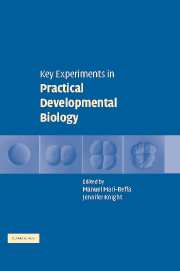Book contents
- Frontmatter
- Contents
- List of contributors
- Preface
- Introduction
- SECTION I GRAFTINGS
- SECTION II SPECIFIC CHEMICAL REAGENTS
- SECTION III BEAD IMPLANTATION
- SECTION IV NUCLEIC ACID INJECTIONS
- SECTION V GENETIC ANALYSIS
- 11 Segmental specification in Drosophila melanogaster
- 12 Genetic analysis of flower development in Arabidopsis thaliana. The ABC model of floral organ identity determination
- 13 Genetic analysis of vulva development in C. elegans
- SECTION VI CLONAL ANALYSIS
- SECTION VII IN SITU HYBRIDIZATION
- SECTION VIII TRANSGENIC ORGANISMS
- SECTION IX VERTEBRATE CLONING
- SECTION X CELL CULTURE
- SECTION XI EVO–DEVO STUDIES
- SECTION XII COMPUTATIONAL MODELLING
- Appendix 1 Abbreviations
- Appendix 2 Suppliers
- Index
- Plate Section
- References
12 - Genetic analysis of flower development in Arabidopsis thaliana. The ABC model of floral organ identity determination
Published online by Cambridge University Press: 11 August 2009
- Frontmatter
- Contents
- List of contributors
- Preface
- Introduction
- SECTION I GRAFTINGS
- SECTION II SPECIFIC CHEMICAL REAGENTS
- SECTION III BEAD IMPLANTATION
- SECTION IV NUCLEIC ACID INJECTIONS
- SECTION V GENETIC ANALYSIS
- 11 Segmental specification in Drosophila melanogaster
- 12 Genetic analysis of flower development in Arabidopsis thaliana. The ABC model of floral organ identity determination
- 13 Genetic analysis of vulva development in C. elegans
- SECTION VI CLONAL ANALYSIS
- SECTION VII IN SITU HYBRIDIZATION
- SECTION VIII TRANSGENIC ORGANISMS
- SECTION IX VERTEBRATE CLONING
- SECTION X CELL CULTURE
- SECTION XI EVO–DEVO STUDIES
- SECTION XII COMPUTATIONAL MODELLING
- Appendix 1 Abbreviations
- Appendix 2 Suppliers
- Index
- Plate Section
- References
Summary
OBJECTIVE OF THE EXPERIMENTArabidopsis thaliana is a model organism for the study of many aspects of plant biology. The acceptance of Arabidopsis as a model system since the 1980s has resulted in part from its advantageous characteristics for genetics and molecular biology research: ease of growth in the laboratory, short life cycle, self-fertilization and ample seed production, ease of mutagenesis and of transformation by exogenous DNA, and a small genome size (Somerville and Koornneef, 2002). The complete genome sequence of Arabidopsis was reported in 2000 (Arabidopsis Genome Initiative, 2000), and many genetic and genomic research tools have been developed in this species. Our understanding of the control of floral organ identity in particular has been greatly advanced by the use of genetic analysis in Arabidopsis.
The objective of the experiment described below is to study the alterations in floral organ identity that are caused by mutations in the homeotic genes that form the basis of the ABC model of flower development (Bowman et al., 1991; Coen and Meyerowitz, 1991).
DEGREE OF DIFFICULTY The experiment described in this chapter is easy to perform, because it consists of studying the phenotype of wild-type and mutant flowers under a stereo microscope. The alternative exercises that are proposed require some experience in crossing Arabidopsis, but this is easily acquired.
INTRODUCTION
In animals, determination of the segmental identities along the antero–posterior body axis depends on the activity of a group of genes identified as homeotic (see Chapter 11), a term coined by William Bateson in 1894 to describe variations that resulted in normal body parts or organs developing at abnormal positions.
- Type
- Chapter
- Information
- Key Experiments in Practical Developmental Biology , pp. 143 - 152Publisher: Cambridge University PressPrint publication year: 2005

